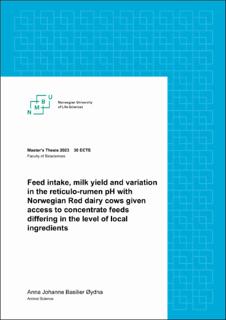| dc.description.abstract | When trying to achieve a higher degree of self-sufficiency, there is a challenge with the high starch levels in grain and the Norwegian climate, which is not particularly well adapted to the cultivation of oil crops. To ensure high milk production, it is important to ensure that the cow has enough rumen-degradable and rumen-indegradable proteins. Because of its nine essential amino acids, soy has been much used as a raw material. The soy sector is highly concentrated and requires large landmasses. The environmental movement has contributed to increased demands for more local food. A high proportion of starch in the feed ration of ruminants can lead to metabolic disturbances, such as subacute rumen acidosis, also referred to as 'subacute rumen acidosis' (SARA). In dairy cows, SARA is characterized by daily episodes of low pH (5.2-6.0) over a longer period, which results in reduced fiber digestion and possibly reduced milk production. Alkaline concentrate has a higher pH, and thus an expected buffer capacity, and this is believed to counteract the negative consequences of feeding with high starch. Alkaline products also contain increased levels of non-protein nitrogen (NPN), and when the rumen microbes are in the presence of easily fermentable carbohydrates from grains and NPN it is expected to produce high quality microbial protein synthesis.
The aim of this study was to evaluate the effect of different concentrate mixtures with alkaline grain in diets for high-yielding dairy cows on feed intake, rumen environment and milk production. The experiment was conducted with a 4x4 Latin square design where 4 different formulations of concentrate (commercial feed (CON), alkaline concentrate with fine physical structure (AUF), alkaline concentrate with coarse physical structure (AUC), and ingredients as in AUC, except that the Alka-150 ingredient has been replaced with grain and urea inclusion (NUF)), tested over 4 periods. All the animals had free access to good quality grass silage. Daily milk production, milk composition, rumen fermentation products, rumen pH, body condition score, and body weight were recorded. No significant effect of the AUF concentrate compared to CON when looking at milk yield, ECM, BCS, and protein yield. There were only numerical pH and VFA differences between the four diets. Substitution of soya with alkaline grains with fine physical structure showed promising results in this trial with high-yielding dairy cows given good quality grass silage. | |
